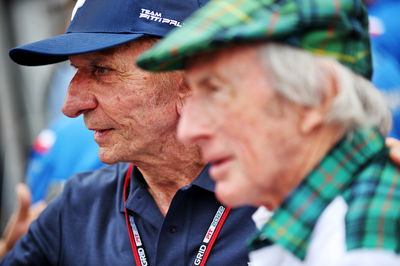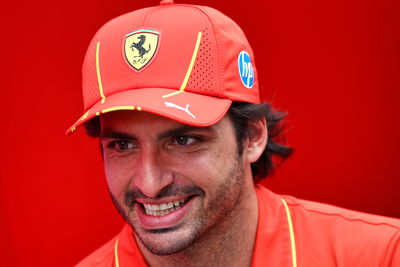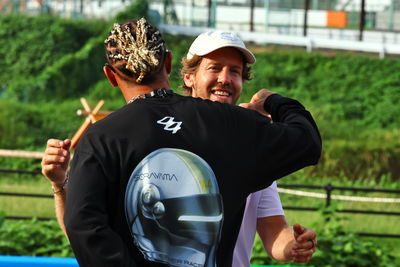EXCLUSIVE: Emerson Fittipaldi on F1’s brutal rules of engagement
How have racing rules changed over the years?

F1 icon Emerson Fittipaldi may be celebrating multiple golden anniversaries this weekend, 50 years since his last Brazilian Grand Prix win en-route to McLaren’s maiden World Championships, and his second drivers’ title.
But, it’s ‘Emmo’s’ thoughts on 1974’s World Championship showdown at the final round in Watkins Glen, USA, with the late Swiss driver Clay Regazzoni that seem just as relevant in McLaren’s current battles as they did then.
The now 77-year-old stated exclusively to Crash.net that he had "no confidence" in wheel-to-wheel battles with the late Swiss driver, then driving for Ferrari – and that, “Sometimes, he’d take he’d take that space that didn’t belong to him."
“If was driving next to Jackie Stewart or Niki Lauda, I could dice wheel-to-wheel with them, and have no problems because they respected the physical space of your car. Clay was tough!"
Fittipaldi made it work, with fourth place in that season decider enough to bring home the World Championship silverware, but only after a last-minute change to the car’s setup ahead of lights out.
Q: How has your year been so far?
Emerson Fittipaldi (EF): “I go to most of the Formula One races. I was in Indianapolis this year, by the way. And I’m very active. But this is my world, my life. I still enjoy it.
Q: Leaving Lotus in 1973 was a big gamble, what was that time like?
EF: “Well, I was already five years in Lotus. Colin Chapman was my mentor. And I was a very good friend of the whole Chapman family. And then at Monza [1973], I still had the chance to win the championship. We had a meeting before the race, with myself, Ronnie [Peterson] and Colin. And we decided if we were leading, with both cars ahead of third place, and if Ronnie would be leading and I was second, we should change positions with 15 laps to go.
"We didn’t have radios at that time. And then with 15 laps to go, it exactly happened as we expected, Ronnie was leading, and I was second. I was right on Ronnie’s gearbox, but we were not dicing. We opened a big gap. But then on lap 15, there was no sign. Lap 14 and 13, no sign either. And then I started racing against Ronnie, he started defending – and I lost the chance in Canada and the United States, too.
"I couldn’t do anything from Jackie [Stewart]. If I’d won Monza, the championship would have still been open. And after that, I decided to leave Lotus, I thought ‘OK, I’d love to work with Colin, but now it’s time to leave.”
Q: So when did you decide to join McLaren?
EF: “Phillip Morris, at that time, was a sponsor. But, they were with BRM, which was not a competitive team. They ask me to join the brand – and they said as long as you change the team, I would have Phillip Morris/Marlboro backing. And then they told me to go to London and look for a team for them [to sponsor]. It was my decision.
"I felt very responsible to get the right team. I went to Ken Tyrrell, it was very successful, and then I went to Bernie [Ecclestone] and that was a very successful car from Gordon Murray. A beautiful Brabham car. And then I went to McLaren, and they had so much motivation, young people from New Zealand. Most of the guys were from New Zealand. I went back to Phillip Morris, and I said I choose McLaren. And they said ‘McLaren never won the World Championship!’ And then we won the first year.
Q: Can you tell me about the M23 car you raced that season?
EF: “The car was already a very good car, very fast. We did a very good winter programme in testing. We improved the car a lot. We started the season very strong from the beginning of the season. McLaren had very good logistics. We didn’t have any telemetry at that time. We didn’t have any information.
"But McLaren was very well organised ahead of every Grand Prix, how we should setup for Brands Hatch, Silverstone, Belgium. Everything was very well prepared before the race, and normally Friday, out of the box, for every Grand Prix we were already competitive. And that was difficult at that time because we could have a wrong setup. But, McLaren were always very precise, we were a united team, everybody was very motivated, Alastair Caldwell was a very good team manager, and had a very good vision and leadership for the team.
"Exactly like now with Zak Brown and Andrea Stella. We have good leaders, and that changed the whole team. That’s what we had at that time as well.
Q: What were your battles with Clay Regazzoni like?
EF: “When I arrived in Europe, Clay was already established, a Formula 2 driver. He was older than me. He was very tough when racing wheel-to-wheel, not easy. Sometimes he’d take that space that didn’t belong to him. For example, every time I was next to Clay, I had no confidence.
"If I was driving next to Jackie Stewart or Niki Lauda, I could dice wheel-to-wheel and have no problems because they respected the physical space of your car. Clay was tough! And going into the last race [of 1974 at Watkins Glen] on equal points, it was the only night of my racing experience where I slept only three hours. I mean, also including the Brazilian Grand Prix, all the pressures I had – that night at Watkins Glen, I only slept three hours, because I knew it was between Clay and I as to who would be the World Champion.
"You work the whole year. There’s so much sweat, so much effort, all the ups and downs, the whole team was working so hard – and to go into the last race on equal points. The track in Watkins Glen was very bumpy; we could not get our suspension frequency correct. And Ferrari could not get it either. And we started on the grid side-by-side. What pressure!”
Q: What was the atmosphere for that championship decider like?
EF: “On the grid, the McLaren boys looked to the Ferrari guys next to us, and we couldn’t look them in the eye. There was so much pressure. The mechanics could not look at us, because they knew after the race either Clay or myself would be World Champion. That’s it, the last race of the year. Tremendous pressure.”
Q: What was that race like?
EF: “Ferrari was very fast on the straight, extremely fast. The Ferrari engine was much faster than our Cosworth engine. During the Sunday morning warm-up, [team manager] Alastair Caldwell suggested we surprise Ferrari – and that we should take off a lot of rear wing. On the full tanks, with the heavy weight, it would be good for the car balance. We took a risk for the second part of the race as there was much less rear wing. They ask me if we should do it, I say yes. That’s it, it’s a do or die race. We took a lot of rear wing.
"They did a good start, two fast corners, and we go to the main straight, and instead of the Ferrari going away from us, I’m catching them with the McLaren. And then I see Clay look in the mirror and he couldn’t believe it. It was exactly the opposite in practice. And I’m sure he got very nervous. I was getting big in his mirrors. And then I went to the inside, mid-straight and he pushed me on the grass in a straight line. Typical Clay! Then I say, that’s it, I turn against the Ferrari, if we crash, we crash, and both finish the race now.
"He then got scared because he never expected me to move against him. He moved his Ferrari, and by the end of the straight I was half a car ahead of him, on the inside line, and then I said I’m not going to look in the mirror on this lap, and I opened a big gap. Because I’m sure with this surprise, he was mentally out of balance. He never expected McLaren to overtake him in a straight line. And that’s all thanks to Alastair Caldwell, his expertise.”
Q: You must be so proud to see McLaren’s recent resurgence?
EF: “Yeah, it’s incredible to see McLaren where it belongs. Any big team has a cycle of performance. And that cycle exists in motor racing since 1950 with the Silverstone race. And this cycle, all the good teams, all the good people, they always come back on top. And that’s what McLaren is doing with the leadership from Zak Brown and Andrea Stella. It’s extremely competitive. That’s great news, and I’m very proud.”
Q: F1 is still so big in Brazil. Why do you think the sport is so popular here, without a local driver on the F1 grid?
EF: “The Interlagos track, it’s a beautiful track, so much history. And we are very lucky, the Brazilians, to have successful drivers – I was the first Brazilian World Champion, then the great Nelson Piquet, and the fantastic Ayrton Senna comes along. And then it was football and motor racing in Brazil, and this year the whole place is full. I mean 30 years since we lost Ayrton, there’s a big commemoration and celebration, it’s amazing the crowds on Friday, today it’s full, it’s fantastic that everybody is motivated because we love motor racing. There’s a big TV audience here in Brazil for Formula One, one of the biggest in the world. It’s great to see everyone is passionate about motor racing.”
Q: 2024 marks 30 years since the passing of Ayrton Senna. How do you reflect on his memory?
EF: “Ayrton was a very good friend, all his life, when I was testing my car the Copersucar-Fittipaldi at Interlagos, he used to come with his father after he had been testing karts next door. He was about 13 or 14 years old, he was very shy in those days. I’d say, “Ayrton, come inside the garage, come have a look at the Formula One car.”
"He was an extremely shy boy, and I helped him – I introduced him to Ralph Firman Snr in England, because Ralph was my Formula 3 mechanic when I won the British championship. And then he started Van Diemen. At that time, it was very big. And I introduced Ayrton to Ralph, and the rest is history. He was a friend, a fantastic driver, and it happened. And now we are commemorating Ayrton Senna’s 30 years.”











